Water birth safety continues to be debated by the American Academy of Pediatrics (AAP) and the American College of Obstetricians and Gynecologists (ACOG). Substantial evidence has been published in the past 3-4 years in support of waterbirth and so I expect to see an updated opinion to be published soon by ACOG and endorsed by AAP.
ACOG & AAP Joint Statement on Waterbirth
The American College of Obstetricians and Gynecologists and the American Academy of Pediatrics most recent statement (2016) about water immersion in labor and waterbirth is less critical of the practices.
The summary of their opinion follows:
Immersion in water during the first stage of labor may be associated with shorter labor and decreased use of spinal and epidural analgesia and may be offered to healthy women with uncomplicated pregnancies between 37 0/7 weeks and 41 6/7 weeks of gestation. There does not appear to be an associated increased risk of adverse maternal, fetal, or neonatal outcomes.
There are insufficient data on which to draw conclusions regarding the relative benefits and risks of immersion in water during the second stage of labor and delivery. Several serious neonatal complications have been reported, but the actual incidence has not been determined in population-based analyses. Therefore, until such data are available, it is the recommendation of the College that birth occur on land, not in water. The College supports conducting well-designed prospective studies of the maternal and perinatal benefits and risks associated with immersion during labor and delivery. Specifically, this document is not intended to prevent the conduct of such studies.
Furthermore, the College recognizes that despite the opinions expressed in this document, a woman may request immersion during the second stage of labor, including giving birth while submerged. This decision should represent an informed choice; a woman who requests to give birth while submerged in water should be informed that the maternal and perinatal benefits and risks of this choice have not been studied sufficiently to either support or discourage her request. She also should be informed of the rare but serious neonatal complications associated with this choice. If the physician believes, based on evidence, that second-stage immersion and giving birth while submerged would be detrimental to the overall health and welfare of the woman or the fetus, he or she should not perform such a delivery.
ACNM Response to ACOG
The American College of Nurse-Midwives issued the following response to ACOG: ACNM, ACOG, and AAP are in agreement that immersion in water during the first stage of labor may be associated with numerous benefits to women; however, ACNM believes this document does not accurately reflect the large and growing body of research that supports water birth as a reasonable choice for healthy women experiencing normal labor as well as birth. ACNM has been in communication with ACOG to express our concerns and our disagreement with the conclusions of this committee opinion, and we will be sending additional up-to-date information on water birth outcomes to ACOG and AAP for the committee’s consideration.
And The Midwives of New Jersey’s Response
How Safe is Waterbirth?
Waterbirth is the single best thing to happen to natural childbirth, ever. When offered within proven guidelines, it is incredibly safe. I can show you 1000+ healthy children to prove it. My practice has offered waterbirth since the year 2000 without any complications related to the birth being in the water-aspiration of tub water causing pneumonia or infection/sepsis. We have seen plenty of the normal complications of childbirth that have happened in the tub. We have learned how to manage shoulder dystocia, hemorrhage, abnormal fetal heart tones, and babies requiring resuscitation quickly and efficiently with no more morbidity than if the woman labored and delivered on land.
In fact, waterbirth is believed to decrease the transmission of Group B strep which can cause pneumonia in newborns. An article published by Cohain considers the studies included in a Cochrane review of immersion in water in labour and birth. (Cluett et al). The Cochrane review concluded that “The safety regarding infection and neonatal outcomes are not addressed, and large collaborative trials are needed to answer these critical issues.” Cohain notes that “The literature provides a single case of early onset newborn Group B Strep (GBS) among 4432 waterbirths, suggesting that low-risk women who give birth in water may have a far lower rate of newborn GBS than women who have a dry birth. The last reported rate of newborn GBS for dry births was 1 in 1450.”
New studies have been published since 2016 that give very compelling evidence that supports waterbirth and refutes ACOG and AAP’s concerns about newborn outcomes in childbirth. Our 2017 conference the New Jersey Symposium for Physiologic Birth: 2017 the Evidence for Choice hosted the author of a huge meta-analysis of waterbirth studies. Jennifer Vanderlaan presented the evidence for waterbirth at our conference and published it May 2018.
Rebecca Dekker, author of Evidence Based Birth, was the keynote speaker at our 2017 Symposium. She has a review of all the waterbirth data on her website. After reviewing the evidence, Rebecca concludes “Based on the data that we have, waterbirth is a reasonable option for low-risk people during childbirth, provided that they understand the potential benefits and risks. If a pregnant person has a strong desire for waterbirth, and there are experienced staff who are comfortable in attending waterbirths, then at this time there is no evidence to deny people this option of pain relief.
Finally, although more research on waterbirth is needed, current evidence shows that hospital “bans” on waterbirth are not evidence-based” (Source).
The Key to Safe Waterbirth
I believe with all my heart and soul that waterbirth is safe in the way that I practice. Our clients sign consents for waterbirth which outline the circumstances in which water labor and birth can occur. I stay with the woman almost continuously in active labor and certainly during the pushing part of labor. I am monitoring the mom and baby very carefully, assessing the safety of laboring and delivering in the tub minute to minute. I believe the key to safety is the presence and assessment of the midwife. I am not sure this is the appropriate mode of delivery for an obstetrician who typically relies on a busy nursing staff to monitor clients during labor until very shortly before the delivery.
Trusting the Birth Process
Waterbirth has changed my practice as a midwife significantly. I have learned how to create a sacred space for women to labor and deliver within and how to take my hands off a normal process. I have virtually eliminated shoulder dystocia from my practice because waterbirth kept me from “helping” the mother deliver her baby’s shoulders and thus wedging the shoulders into the pubic bone. I now use a very hands off approach to ALL of my births with better outcomes. I cannot “protect” a woman’s perineum with my hands in waterbirth and I realized that I was often protecting nothing and breaking a lot. Waterbirth has shown me that it is not important for me to see the vagina or the baby’s head for the delivery to go well. Because the baby will not fall but float, the mother can assume a very commonly preferred position- on her knees with baby delivering beneath her and suffer less difficulty delivering the baby, less perineal trauma and way more autonomy!
The Benefits of Water Immersion
Women will attempt an unmedicated birth if offered proven methods of non-pharmacologic pain relief like water labor and birth. Water immersion decreases adrenaline and increases endorphins and oxytocin. Laboring in water is a huge benefit to the woman by making labor less painful and more autonomous. But if we do not allow the actual birth of the baby to occur in the water, we risk disrupting the progress of labor by increasing the pain women experience. We take her out of her “zone” when we instruct her to leave the birth pool. Women report a great satisfaction with water birth, more than with water immersion in labor. Women have often reported to me that even though they had people around them for their waterbirth, they felt completely alone with their baby after the birth, this is nature at its best. The high level of oxytocin, endorphins and adrenalin are the perfect hormonal cocktail for initiation of the most important bond a human ever experiences. I am in the business of changing the world through birth. I believe that showing women how incredible and powerful they are in a natural birth will change them as women and as mothers forever. Waterbirth must become an available birth choice for women in the USA.








 How You Fall Asleep Could Increase Stillbirth Risk
How You Fall Asleep Could Increase Stillbirth Risk

I’m pregnant in my fifth month with my fifth baby. I’d like to get more information on waterbirth and I’d like to connect with a midwife.
My first four were regular vaginal birth in the hospital toed to a bed with medication. This time I would like to take the natural birth route.
Please advise accordingly.
Love and light,
Pearl Reich